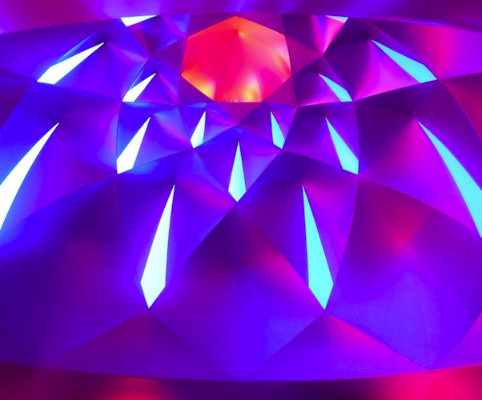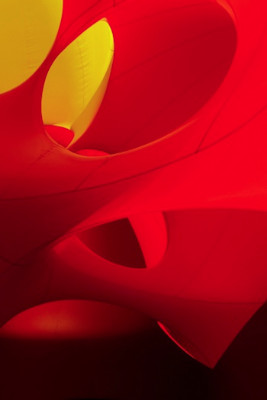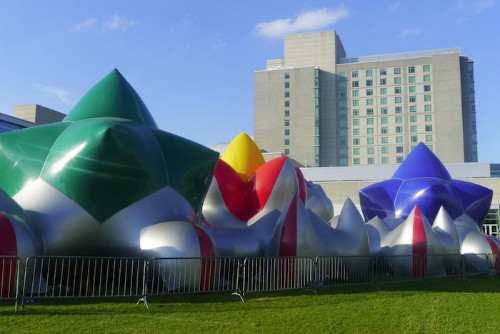The Pentalum at Lawn on D
A Marvelously Trippy Light Show
By: Mark Favermann - Jan 10, 2016
Like some sort of unworldly mushrooms set on the Lawn on D next to Boston Convention & Exhibition Center in South Boston, the “Pentalum” (exhibited on May 28 through 31, 2015) consisted of equal parts floating fantasy village, contemporary carnival ride, and pop-up environmental art installation. Though it has been seen by over 2 million visitors in 38 countries, the piece had never before been seen on the U.S. East Coast. The popularity is understandable: “Pentalum” is a public art happening for every age. Based upon the physical integration of color and form, this walk-through experience is a very engaging and delightful serving of the light fantastic. It is just a lot of fun.
“Pentalum” is an example of soft, temporal architecture: its geometric sculptural forms push against the boundaries of an interactive environmental art installation. The outside of the structure is radically different than the interior; in fact, the exterior design seems much less inspired than the interior. From the outside, “Pentalum” reminds you of a giant plastic bounce house, but inside it is a visually stunning colored maze experience. The inner space is organically intense, proffering an inner beauty that is peaceful, yet contains a visually playful energy.
Created by Architects of Air, an English/French team, “Pentalum” was built in 2013. The goal was to create a visual experience whose marriage of light and geometry produced vibrant colors. Based on the luminaria, a celebratory votive candle that is customarily contained in a paper lantern, the designers made use of forms based on a Platonic solid — the dodecahedron — though they also drew on geometric variations described by Archimedes and other classical mathematicians.
Architects of Air were inspired by these forms: they felt that geometric structures that don’t make use of symmetrical axes inevitably generate a sense of discovery. The pentagon serves as the basis for the main structural elements of the “Pentalum,” with the exception of the Main Dome. In order to achieve more volume, the larger dome area is configured in a heptagonal form, which creates an elegant asymmetry.The outer dodecahedral domes all have a seam motif that is based on a flattened dodecahedron, so that these domes become dodecahedrons within pentagons within dodecahedrons. Geometry enthusiasts rejoice!
From the outside, “Pentalum” resembles a 3D cartoon village of star-shaped soft structures, about 20’ high and 180’ across. At first, the pieces appears to be more funride than art event. Its interior layout is a series of round passages and short tunnels opening onto various domed chambers. These are arranged in glowing blue, red, yellow, and green with soothing background music. The entertaining impression is of a sci-fi space station intersecting with a present day multi-generational play space. The somewhat bulbous domes are large chambers that rise up to 10 meters high; they provide the visual focal points. The tunnels connect the domes and which path you take determines the visitor’s journey.
Each luminarium is a dazzling maze of winding paths and soaring domes that combine aspects of Islamic architecture, Archimedean solids, and Gothic cathedrals. The overall experience is of an indelibly beautiful display of various lights and colors. The intrinsic beauty of “Pentalum” is that it is totally engaging even when there isn’t an abundance of light. Clouds don’t seem to matter. It literally provides “sunshine on a cloudy day.”
The luminaria are the creations of the company’s founder, Englishman Alan Parkinson, who started experimenting with pneumatic sculptures in the I980s. He designed and built his first luminarium at Nottingham, UK in 1985. They are made of a plastic sheeting and are custom produced for Architects of Air. Only four colors of plastic are used, but they generate a dazzling diversity of subtle hues.
Architects of Air are currently touring 6 luminaria internationally. Each luminarium is made up of around 20 elements that are zipped together on site, typically occupying an area of 1000 square meters. Seemingly easy to erect, laying out the structure and anchoring can take about 4 hours or so and then, in just 20 minutes, the luminarium is inflated to its monumental size. They take considerably less time to deflate. The company has 6 permanent staff members and employs 15 or more temporary staff for touring and construction. Since Architects of Air’s founding in 1992, the company has built 21 luminaria.
For those of us old enough to remember, the twisting tunnels and open colorful spaces in the “Pentalum” are redolent of a near psychedelic experience (with bits of immersive disco inferno tossed in). This is captivation by color ’60s style — sensory overload encouraged.
Lawn on D is a project of the Massachusetts Convention Center Authority, which launched the space last summer as an 18-month try-out for the MCCA’s plans to develop year-round programming next to the huge Boston Convention Center. Last year, the effort’s first, was a popular success — an inventive selection of art, music, and play areas was enjoyed by thousands of people. With the BCEC’s building expansion plans currently on hold, the Lawn on D will happily remain open and continue with engaging programming into the foreseeable future.
This article is being republished by permission from Arts Fuse.



